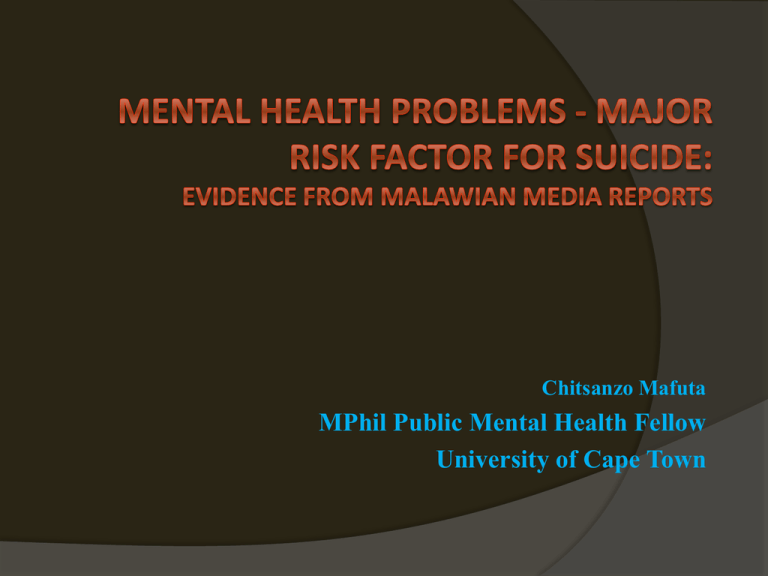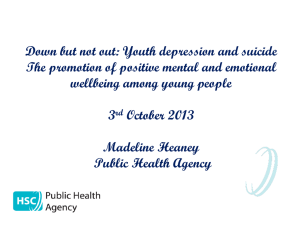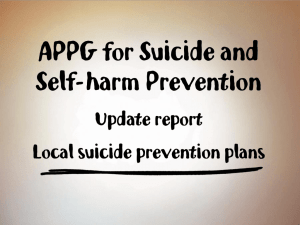
Chitsanzo Mafuta
MPhil Public Mental Health Fellow
University of Cape Town
“All too often, suicide represents a
tragic consequence of failing to
diagnose and treat serious mental
illness” Dr. Anders Nordstrom,
Acting Director-General of WHO
(2006)
Introduction
•
Suicide is defined as an act with fatal outcome
that is deliberately initiated and performed by
the person in the knowledge or expectation of
its fatal outcome1
•
Suicide methods include:
–
–
–
–
Drug overdose, poisoning
Hanging, Drowning
Gunshot
Jumping from heights, onto or from running vehicles
1Gelder,
M., Harrison, P., & Cowen, P. (2006). Shorter Oxford Textbook of
Psychiatry.(5th Edition). New York: Oxford University Press
Epidemiology
Every year 1 million people die from suicide;
a global mortality of 16 per 100,000, or 1
death every 40 seconds2
In Malawi: 2,269 deaths (1.09% of total deaths)
Aged adjusted death rate is 23.32 per 100,000 of
population ranks Malawi #6 in the world3
Suicide is #16 as cause of death in Malawi
2World
Health Organization: Suicide Prevention. Accessed on April 17, 2013. Available on
http://www.who.int/mental_health/prvention/suicideprevent/en/index.html
3WHO
(2011). Malawi: Suicide. Accessed on April 15, 2013. Available on
http://www.worldlifeexpectancy.com/malawi-suicide
Laws in individual jurisdictions
•
•
Malawi, Kenya, Nigeria, Rwanda, Tanzania,
Ghana and Uganda are among other African
countries that currently criminalize nonfatal
suicidal behavior5
In Malawi, suicide attempters have been
convicted and sentenced to several months
or years of imprisonment with hard labour
5Kanjo,
M. (2011, February 25). Why is suicide a crime? Retrieved from
http://www.nationmw.net/index.php?option=com_content&;view=artikel&id=15100:why-is-suicideacrime&catid=236:think
Laws in individual jurisdictions
In Zambia6, Zimbabwe7, UK and Wales8, suicide is
not a crime
The laws of these countries are against inciting
and assisting suicide
6Suicide
Act, 1967 of Zambia
7Criminal Law Code, 2004 of Zimbabwe
8Suicide Act, 1961 of England and Wales
Link between Suicide and Mental illness
Suicide is a multidimensional disorder9
• Between 40% - 60% of people who commit
suicide saw physician in the month prior to
suicide
• Overall prevalence of mental disorders is 80100% in cases of completed suicide
• Lifetime risk of suicide in people with
•
– Mood disorders (chiefly depression) is 6-15%
– Alcoholism, 7-15%
– Schizophrenia, 4-10%
9WHO
(2009). Preventing Suicide: A Resource for General Physicians. Geneva
Who is at risk of suicide?
Higher risk groups:
• Gender: 3 times common in men than women
• Marital Status: Never married, widowers,
widows, & divorced
• Professions: (vets, pharmacists, farmers,
doctors)
• Previous History of attempts
• Psychiatric Disorder or substance abuse
• Experience of stressful life events10,11
10Joiner,
T. (2005). Why people die by suicide. Cambridge, MA: Harvard University Press.
11Joiner, T. (2010). Myths about suicide. Cambridge, MA: Harvard University Press.
Stress-Vulnerability Model
VULNERABILITY
+
STRESS
-/+
COPING STRATEGIES
=
DISTRESS (mental health problem)
Evidence from Malawian Media Reports
Electronic search of articles on suicide cases
carried out in Malawi since inception of online
newspapers (late 2006)
Eligibility criteria
Age; Sex; Method; Reason for committing suicide or
associated factors; & outcome
30 cases were found
Thematic approach was used to analyze data
Results
25 males; 5 females
Age range: 15 – 86 yrs
Mean: 36.93 yrs (SD 19.405)
Suicide methods used
Hanging: 27 cases (90%)
Drug overdose: 1 case (3.3%)
Stabbing: 1 case (3.3%)
Gunshot: 1 case (3.3%)
Results continued
Outcome
Completed: 29 cases (96.7%)
Attempted: 1 case (3.3%)
Psychosocial stressors
Relationship problems
Poverty related
Chronic physical illness, Chronic psychiatric illness, Positive
HIV status
Excessive alcohol use
Fearing to be arrested
Unknown but associated factors, single parenthood and
alcohol use
Age
Suicide Methods
Psychosocial Stressors
Limitations
•
Print newspapers were not included
• Failed to get all reported cases because
did not meet eligibility criteria
• Sample is too small to generalize the
findings
Discussions
•
Use of media reports is one approach to
understand suicide in developing countries like
Malawi which usually have no organization
acting as central suicide registry12
• Central Suicide registry is important for a
country in order to understand burden and
develop proactive strategies
12Adinkrah,
M. (2011). Epidemiologic characteristics of suicidal behavior in
contemporary Ghana. Crisis: The Journal of Crisis Intervention and Suicide
Prevention, 32, 31-36.
Discussions
•
Motivation or stressors for suicide in this review
are consistent with several studies11,10,14
•
Findings of suicide methods are different to
hospital-based study which revealed pesticide
poisoning, 66 cases out of 84 (79%) and self
immolation13
13Dzamalala,
C. P., Milner, D. A., & Liomba, N. G. (2006). Suicide in Blantyre, Malawi (2000-2003). Journal of
Clinical Forensic Medicine, 13 (2):65-69
14Adinkrah,
M. (2012). Criminal Prosecution of Suicide Attempt Survivors in Ghana. International Journal of
Offender Therapy and Comparative Criminology. Accessed on April 17, 2013. Available on
http://ijo.sagepub.com/content/early/2012/08/21/0306624X12456986
Conclusion
•
Suicide is indeed huge but preventable
public health problem
• It requires a concerted public health
response to reduce suicide by reducing
mental illness
• Mental health problems indeed constitute
major risk factor for suicide
Recommendations
Establishment of central suicide registry
Comprehensive research on extent of
suicide in Malawi
Psychological autopsies
Epidemiological studies
Revise current pathway to care
Food for thought
Is decriminalization
or depenalization of
suicide important in
Malawi?










